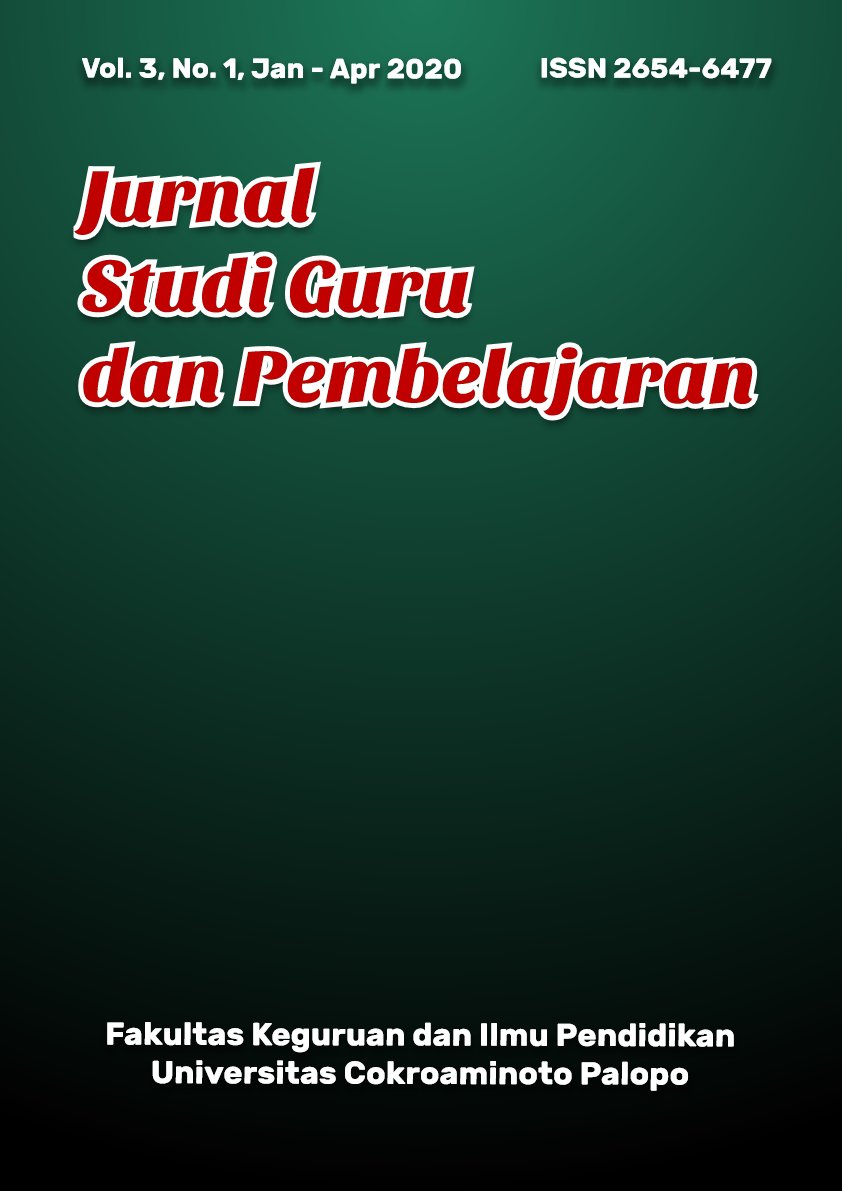Penggunaan E-Learning Sebagai Media Dalam Proses Belajar Bahasa Inggris di Universitas Darwan Ali Sampit
DOI:
https://doi.org/10.30605/jsgp.3.1.2020.235Keywords:
e-learning, information technology, English languageAbstract
Penelitian bertujuan untuk mengetahui peran, fungsi serta manfaat bagi mahasiswa dalam pembelajaran Bahasa Inggris dengan menggunakan E-learning di Universitas Darwan Ali. Jenis penelitian ini adalah deskriptif dengan menggunakan pendekatan kualitatif. Teknik pengumpulan data menggunakan wawancara mendalam, studi literatur, dokumentasi, dan observasi. Hasil penelitian menunjukkan bahwa 1) E-learning di Universitas Darwan Ali Sampit memiliki peran untuk fasilitas rencana perkuliahan dalam proses belajar bahasa Inggris. 2) E-Learning memudahkan mahasiwa dalam memahami pembelajaran karena membuat mahasiswa lebih tertarik dan bisa diakses kapanpun dan dimanapun selama ada akses internet. 3) Mahasiswa bisa mendapatkan materi dan bahan pembelajaran dalam berbagai bentuk seperti teks, gambar, dan video. 4) kemampuan mahasiswa berkembang dalam pembelajaran Bahasa Inggris seperti kosa kata, menulis dan membaca. 5) Mahasiswa menjadi lebih aktif dan antusias dalam proses pembelajaran.
Downloads
References
Adrelia, D. I. (2015). Permainan bom angka dalam konsep kelipatan persekutuan terkecil untuk anak sekolah dasar. Jurnal Elemen, 23-35. DOI: https://doi.org/10.29408/jel.v1i1.77
Briton, I. (2010). Company Profile. Makasar: HRD Briton IES Makassar.
Dakir, H. (2010). Perencanaan dan pengembangan kurikulum. Jakarta: Rineka Cipta.
Hamalik, O. (2011). Dasar-dasar Pengembangan Kurikulum. Bandung: Remaja Rosda Karya.
ihwanah, A. (2016). Implementation E-Learning in Learning Process PGMII IAIN. Cakrawala.
Jayawardana, H. (2017). Paradigma Pembelajaran Biologi di Era Digital. BIOEDUKATIKA, 12-17. DOI: https://doi.org/10.26555/bioedukatika.v5i1.5628
Kurniawan Sabar, A. R. (2011). Penggunaan Web (E-Learning) Dalam Proses Pembelajaran Bahasa Inggris Di Briton International English School Makassar. KAREBA: Jurnal Ilmu Komunikasi, 444-456.
Lim, H. (2007). The Role of E-Learning in Increasing Interest and Learning Process in Mandarin: Case Study of Chinese Literature Students at Bina Nusantara. Lingua Cultura, 157-167. DOI: https://doi.org/10.21512/lc.v1i2.322
Wicaksono, S. R. (2015). Computer Supported Collaborative Learning Berbasis Blog. Malang: Seribu Bintang.
Sadiman. (2009). Media of Education: Definiton, Development, and utilization. Jakarta: Rajawali Pers.
Saifuddin, M. F. (2017). E-Learning Dalam Persepsi Mahasiswa. Varia Pendidikan, 102-109. DOI: https://doi.org/10.23917/varidika.v29i2.5637
Sanjaya, W. (2010). Kurikulum Dan Pembelajaran. Jakarta: Kencana.
Smaldino, S. E. (2008). Instructional Technology and Media for Learning (Ninth Edition). New Jersey: Pearson Education.inc.
Triyanti, M. (2015). Pengembangan Multimedia Interaktif pada Materi Sistem Saraf untuk Meningkatkan Motivasi dan Hasil Belajar Siswa SMA Kelas XI. JURNAL BIOEDUKATIKA, 9-14. DOI: https://doi.org/10.26555/bioedukatika.v3i2.4148
Turino, D. (2009). E-Learning Bahasa Inggris Berbasis Web. Jurnal Teknologi Informasi.
Downloads
Published
How to Cite
Issue
Section
License
In submitting the manuscript to the journal, the authors certify that:
- They are authorized by their co-authors to enter into these arrangements.
- The work described has not been formally published before, except in the form of an abstract or as part of a published lecture, review, thesis, or overlay journal.
- That it is not under consideration for publication elsewhere,
- That its publication has been approved by all the author(s) and by the responsible authorities – tacitly or explicitly – of the institutes where the work has been carried out.
- They secure the right to reproduce any material that has already been published or copyrighted elsewhere.
- They agree to the following license and copyright agreement.
License and Copyright Agreement
Authors who publish with JSGP agree to the following terms:
- Authors retain copyright and grant the journal right of first publication with the work simultaneously licensed under Creative Commons Attribution License (CC BY-SA 4.0) that allows others to share the work with an acknowledgement of the work's authorship and initial publication in this journal.
- Authors are able to enter into separate, additional contractual arrangements for the non-exclusive distribution of the journal's published version of the work (e.g., post it to an institutional repository or publish it in a book), with an acknowledgement of its initial publication in this journal.
- Authors are permitted and encouraged to post their work online (e.g., in institutional repositories or on their website) prior to and during the submission process, as it can lead to productive exchanges, as well as earlier and greater citation of published work.














